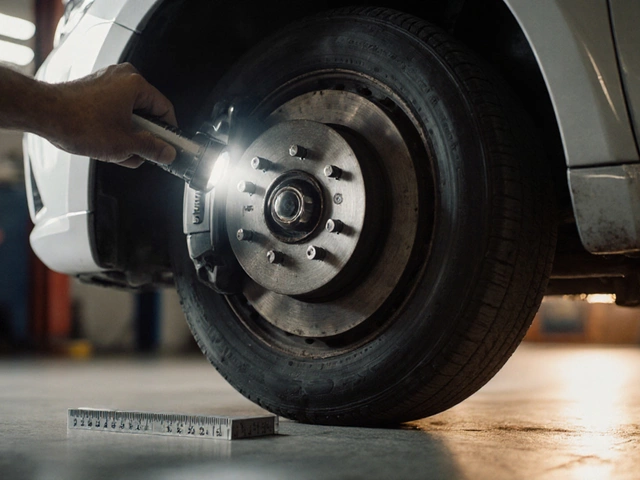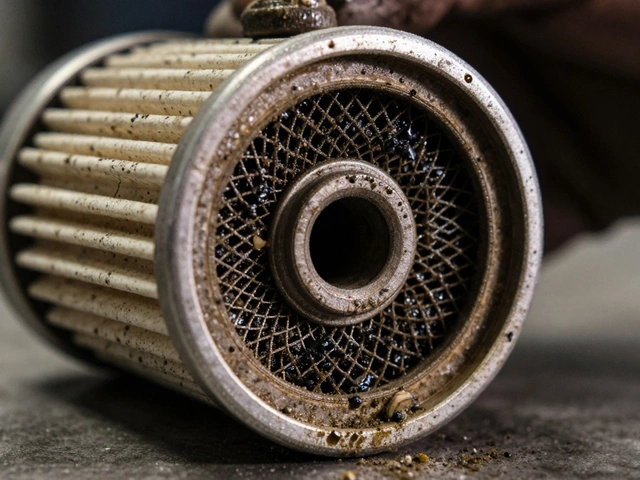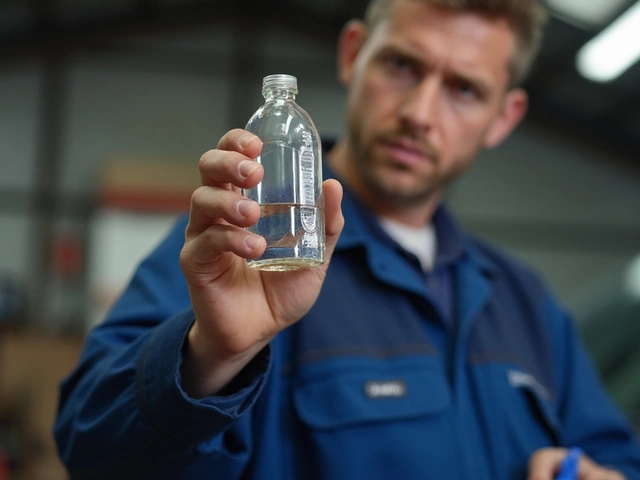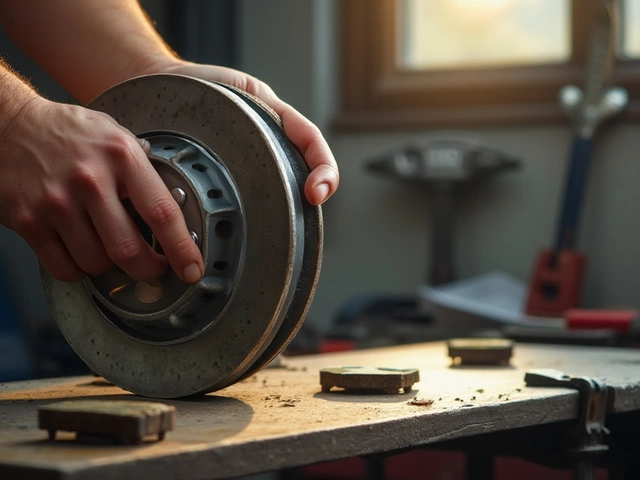If your car feels shaky, you hear odd thunks, or you notice tire wear that wasn’t there last month, you’re probably staring at a suspension issue. Too many folks shrug off little changes, but the suspension system isn’t just about comfort—it holds your ride together, keeps you in control, and saves your tires from disaster.
Want to know what really takes out a car’s suspension? It’s not always that one wild pothole. Most of the time, it’s a mix of small daily stuff you don’t notice: hitting curbs, loading up the trunk like you’re moving house, ignoring warning signs. Even something as simple as parking outside every night adds up—yep, weather can kill suspension parts faster than you’d guess.
Understanding what ruins your suspension early can save you cash and headaches. I’ll break down how it all works, the biggest troublemakers, and how you can keep your car running smooth without fancy tools. Plus, you’ll learn a few quick checks you can do at home—even with your dog circling the driveway.
- How Suspension Works
- Common Signs of Suspension Trouble
- Main Causes of Suspension Damage
- Bad Habits That Speed Up Wear
- Weather and Environment Impact
- Tips to Make Suspension Last
How Suspension Works
Your car’s suspension is like its backbone. It keeps everything steady, even when the road is a mess. Most setups have three main parts doing all the work: springs, shocks (or struts), and control arms.
Springs do the heavy lifting. They absorb bumps and dips, so your car doesn’t bounce all over the place every time you roll over a pothole or speed bump. Shocks and struts are the next bit—they keep the spring’s bounce under control, so you don’t feel like you’re on a trampoline. Control arms hold your wheels steady, keeping their position correct even when the car turns or hits a bump.
Together, these parts make sure the tires stay in contact with the road. That’s not just for comfort—it’s a safety thing. If your tires lose contact, your car can skid or swerve. Here’s a quick look at the key pieces and what they do:
- Shocks and Struts: Dampen the bounce from the springs. If they go bad, you’ll notice every bump.
- Springs: Hold the car up and soak up the hits from rough roads.
- Control Arms and Bushings: Link the wheels to the body, letting them move up and down but not sideways.
- Sway Bars: Keep the car from rolling in sharp turns.
Even if you don’t care about car engineering, check this out: A study by the U.S. Department of Transportation found that roughly 40% of suspension issues lead to decreased steering control. That’s a big safety deal.
| Suspension Part | Main Job | Common Problem |
|---|---|---|
| Shocks/Struts | Dampen and control bounce | Leaking fluid, worn seals |
| Springs | Support weight, absorb impact | Sagging, breaking |
| Control Arms | Guide wheel motion | Bushing wear, bending |
| Sway Bars | Reduce body roll | Broken links, worn bushings |
If you want your car to handle safely and last longer, keeping your car suspension in good shape isn’t optional—it’s a must. In the next section, you'll see how to spot when things start going wrong.
Common Signs of Suspension Trouble
Spotting suspension issues early keeps your repair bills lower and stops those dangerous surprises on the road. It’s not just about comfort—bad suspension messes with your grip and steering, and really beats up your car suspension parts. Let’s get into the stuff most people actually notice first.
- Uneven tire wear: If one side of your tires is balder than the other or you spot odd patterns on the tread, your suspension might be out of whack.
- Car drifting or pulling: If the car wants to slide sideways or you constantly correct the steering to drive straight, your suspension probably isn’t holding things together properly.
- Excessive bouncing: Hit a speed bump and your car keeps bouncing? Worn shocks or struts can’t control those up-and-down movements anymore.
- Loud noises over bumps: Clunking, knocking, or squeaking when you go over potholes or rough spots aren’t just annoying—they often mean broken mounts, bushings, or other suspension bits.
- Nose diving or rear squatting: If your front end dips hard when you brake, or the back squats low when you speed up, your suspension can’t handle weight shifts like it should.
- Steering feels off: Loose, shaky, or stiff steering can sometimes point straight to suspension problems, not just issues with your steering rack.
Here’s a quick look at how serious some of these symptoms can get if ignored:
| Sign | Possible Cause | Risk if Ignored |
|---|---|---|
| Bald tire edges | Bad alignment, worn parts | Blowout, slippery handling |
| Clunking noise | Broken bushings or links | Parts failure, loss of control |
| Persistent bouncing | Dead shocks/struts | Bad handling, longer stops |
| Pulling/drifting | Mismatched suspension height | Crash risk, uneven wear |
If you’re checking your car and notice more than one of these signs, it’s time to get the suspension looked at. Don’t wait for a small clunk to turn into a breakdown on the highway. Little things now mean big savings later.
Main Causes of Suspension Damage
Most folks think one huge pothole is the main villain when it comes to wrecking your car suspension, but that’s only part of the story. The truth? Daily wear and habits do most of the damage, and a lot of it sneaks up quietly. Here’s a look at the biggest troublemakers:
- Potholes and Rough Roads: Smacking a deep pothole or crossing railroad tracks too fast puts sudden, intense force on shocks, struts, and control arms. According to AAA, the U.S. spends about $3 billion a year on pothole-related vehicle repairs.
- Rust and Corrosion: Suspension parts like springs, links, and bushings are often steel. Rain, road salt, and humidity eat away at them. Rust can weaken metal parts until they snap—especially in places with salty winter roads or by the coast.
- Worn Bushings and Ball Joints: These rubber and metal bits take tons of abuse every drive. Once they dry out or wear thin, you get clunks, wobbles, and even steering issues.
- Overloading: Loading your car over its weight limit—think moving home in one haul or always hauling tools—stresses the suspension till it sags or breaks. Even towing a trailer that’s too heavy can ruin springs and shocks quickly.
- Lack of Maintenance: Skipping routine checks is a killer. If you never check your shocks, you might not know they’re leaking oil or loose until it’s too late.
- Neglecting Tires: Bad tires or wrong air pressure put more heat and stress on suspension components. Rotating and balancing tires matters more than most people think.
Here's a quick table showing what hits different suspension parts hardest:
| Suspension Part | Main Cause of Damage | Common Sign |
|---|---|---|
| Shocks/Struts | Potholes, Overloading | Bouncy ride, oily leaks |
| Springs | Rust, Heavy Loads | Sinking corner, uneven stance |
| Bushings | Wear, Heat, Drying out | Clunks, vibration |
| Ball Joints/Tie Rods | Road impacts, Corrosion | Loose steering, noise over bumps |
If you spot any of these warning signs, don’t wait around. Suspension damage is one of those things that just gets worse—and more expensive—if you ignore it. Keeping an eye out for rough ride quality, uneven tire wear, or any weird noises gives you a fighting chance to catch problems early.
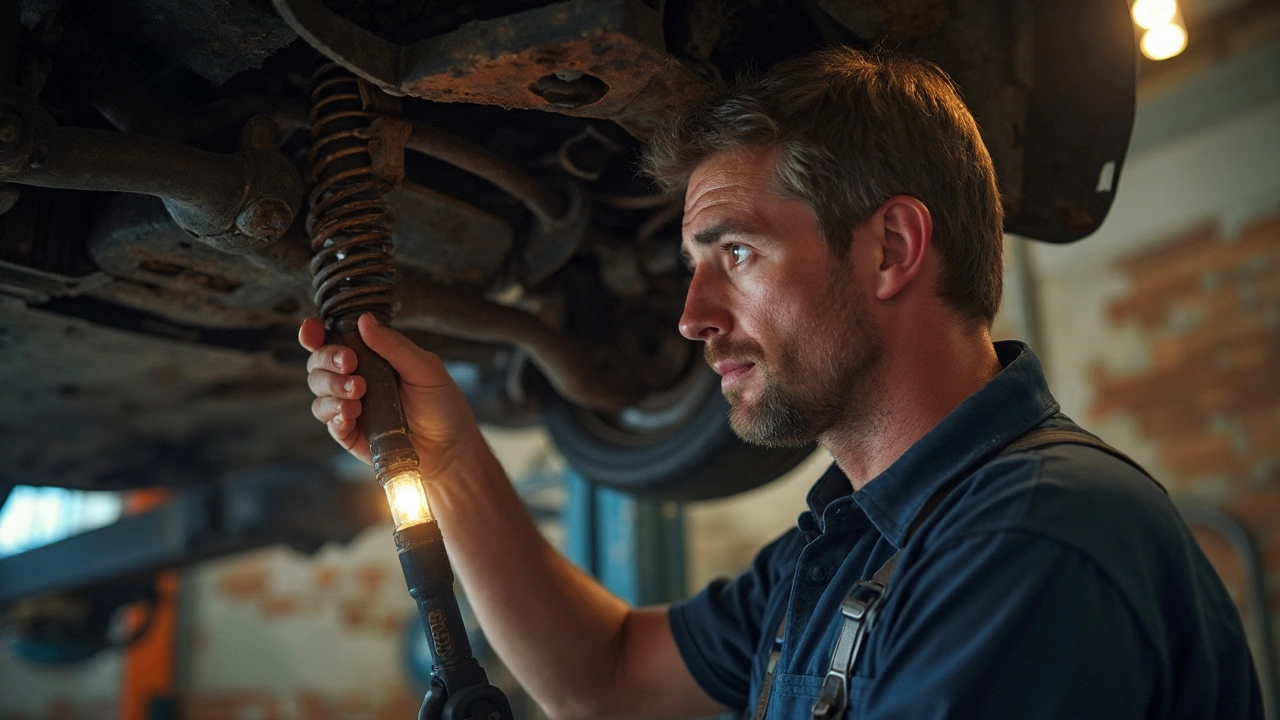
Bad Habits That Speed Up Wear
Most drivers don’t realize their daily choices are quietly wrecking their car suspension. It's not just big accidents—small mistakes, done over and over, cause more trouble in the long run. Here’s the stuff that really grinds gears (and shocks, and bushings):
- Speeding over potholes and speed bumps: That "thump" sound? Every hard jolt stresses shocks, struts, and joints.
- Ignoring load limits: Packing in people, pets, and gear regularly makes the suspension work way harder than it should. The owner’s manual isn’t kidding about weight limits.
- Hitting curbs while parking or turning: It happens to the best of us (I’ve watched Rufus bark at the curb as if it’s the problem). But that sudden impact bends or snaps components over time.
- Skipping routine checks: If you don’t listen for weird noises or check tire wear now and then, early signs of suspension issues go unseen.
- Letting old shocks and bushings linger: Worn parts can’t absorb bumps, so the rest of the suspension takes the hit. That quick squeak or mild bounce? Ignoring it will cost you more later.
- Driving with uneven or low tire pressure: Being lazy about tires messes with balance and puts extra strain on suspension parts.
Want to see how these habits wear things out? Here’s a look at repair data from AAA on common causes of suspension repairs:
| Bad Habit | Estimated Share of Suspension Repairs |
|---|---|
| Hitting potholes/damaged roads | 32% |
| Overloading the car | 17% |
| Skipping maintenance | 29% |
| Curbed wheels/parking dings | 9% |
| Poor tire maintenance | 13% |
It’s simple: treat your suspension like it matters and a lot of long-term headaches disappear. Check up on your car every few months, go easy on bumpy roads if you can, and pay attention to anything that feels off. These small habits keep you riding smoother, longer—and out of the repair shop. Trust me, it’s less stress for you and your wallet.
Weather and Environment Impact
People always talk about wear and tear, but they forget how much weather and environment beat up your car suspension. Living in a place with gnarly winters? The salt they dump on icy roads might keep you upright, but it also loves to eat away at your suspension parts—think rust, fasteners getting loose, and bushings cracking. Summer’s not your friend either. Crazy heat dries out rubber bushings and seals more quickly than you’d expect.
Dirt roads can chew up your shocks quicker than city streets, and all that mud or gravel gets stuck where you least want it—around moving joints, wearing them down. If you live near the beach, salt in the air is just as sneaky as the stuff on roads in winter. Ever park under a tree for weeks? Tree sap and pollen can hold moisture close to metal, leading to corrosion.
"Rust is the number one killer of suspension components in regions with heavy road salt usage. Regular rinsing underneath your car can extend the life of these expensive parts." — Car Care Council
Here are some real numbers to drive it home. A Consumer Reports test found that cars in the Midwest (where road salt is king) had 35% more suspension rust after just four winters compared to cars in dry southern zones. That means you’re way more likely to need new control arms or shocks sooner if you’re driving winters up north.
| Environment | Common Threats | Average Lifespan Impact |
|---|---|---|
| Heavy snow & salted roads | Rust, worn bushings | Up to 40% shorter part life |
| Beach/coastal areas | Salt air, corrosion | 25% shorter part life |
| Dirt/gravel roads | Stone chips, dust | Faster shock/strut wear |
| Arid/hot climates | Dried seals, rubber aging | Up to 15% faster rubber wear |
If you’re in one of these tough spots, you’ve got to fight back. Here are some easy steps:
- Give your car’s underside a rinse after winter storms or beach trips.
- Check suspension parts for cracks or rust every few months—catching problems early is cheaper.
- If you spot lots of dust or mud around the wheels, clean it off before it cakes up and wears on moving joints.
- Use rubber-safe sprays to protect bushings from UV and heat aging.
Your suspension hates surprise attacks from the environment, but regular cleaning and a quick look around every now and then will keep things rolling longer—and smoother.
Tips to Make Suspension Last
Keeping your car’s suspension in good shape isn’t rocket science, but a few key habits make a huge difference. Most people wait until things go wrong—don't be that person stuck on the side of the road while everyone else gets to brunch. Trust me, your wallet will thank you if you get ahead of the game.
- Car suspension loves regular checks. Take a minute every few weeks to look for leaky shocks, worn bushings, or uneven tire wear. Just a flashlight will do—no fancy gear needed.
- Rotate your tires every 5,000 to 7,500 miles. It’s boring, but it spreads out the wear on your suspension and saves money on tires too.
- Steer clear of potholes and avoid hopping curbs, even if you’re in a rush. One hard hit can bend a strut or snap a spring.
- Keep your load light. Too much stuff in the trunk or back seat puts extra strain on all those suspension parts holding up the car.
- Rinse the undercarriage after driving on salted roads, especially in winter. Salt triggers rust and makes parts like control arms and sway bars rust out faster than you’d expect.
- If something doesn’t “feel right” or you hear a new noise, get it checked. Early fixes can cost a hundred bucks instead of a four-figure nightmare.
Here’s a quick-look table for when to do what if you want your suspension to go the distance:
| Checklist Item | How Often |
|---|---|
| Inspect shocks/struts | Every oil change |
| Rotate tires | Every 5,000-7,500 miles |
| Wash undercarriage (salt season) | Monthly (more in winter) |
| Listen for new noises | Every drive |
| Monitor ride comfort | Ongoing |
Simple stuff really ups your odds of avoiding major suspension repairs. Bonus tip: If you’ve got a dog like Rufus that sheds everywhere, keep the back seats clear so you’re not loading up extra weight with crates and dog supplies. Little things add up.


